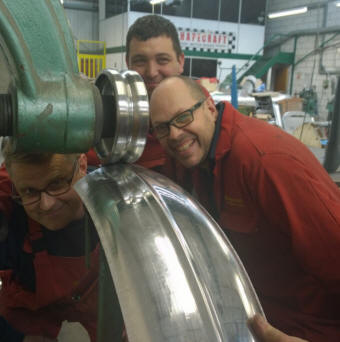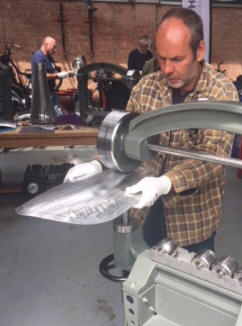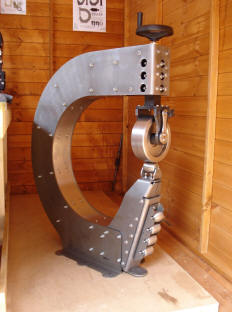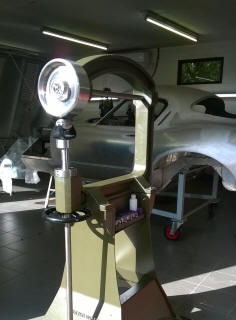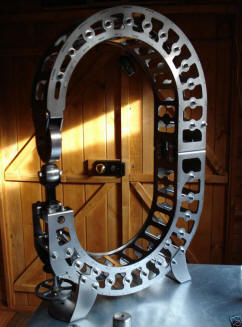history of the wheeling machine
Also known as "English Wheels"
A brief history
Sheet metal was traditionally the original craft
of a blacksmith, hammering metals to make armor,
"beating" them out of flat sheet metal over
anvils, shot or sand bags or using hollowed-out
wooden forms as patterns. The recognition of the
panel beating trade occurred circa 1900 due
mainly to the developing automotive industry.
Body building involved a great deal of intensive
work, because each body part had to be very
smooth, the industry developed, the trade became
highly skilled, organized, and respected
worldwide.
As the automotive and aviation industries grew
larger, mainly due to the war around that time,
requirement for quality increased as did the
need to form large panels free of hammer marks
and the stresses produced from hammering the
material. From this necessity the English wheel
was born.
The exact date of the first machine isn't known,
but it is thought that the concept was first
produced in France in medieval times, where
possibly a wooden frame was utilized.
Commercial production is thought likely to be
around 1890 possibly produced by large foundries
in the midlands, which is still to this day the
heart of sheet metal craft.
At that time there were a few large engineering
companies with sufficient knowledge and
industrial expertise to produce the vast
castings required. Edwards was one such firm,
marketing the equipment from their London
premises. Kendrick, and Ranalah where also well
known manufacturers from around 1900 onwards,
producing machines with throat sizes of up to 48
inches (120cm), primarily aimed at the aviation
industry.

Most of those early machines still remain in use
to this day. These are widely respected machines
that command high prices when they are offered
on the market, although they rarely come up for
sale. For example, a 42 inch machine in working
order is likely to achieve upwards of £6,000
and, if you’re lucky, you might get the matching
anvils, although these would have been well
worked and have become extraordinarily hard due
to them becoming “work-hardened” over the years,
much like a railway track ages over time.


Some of these machines are nearing a century old
obviously wear out, but as with most good
quality engineering, these machines can be
brought back to life by replacing worn or
missing parts, as the components tend to be
fairly simple to reproduce. “Hollowing” of the
top anvil is a common problem and the anvil can
be re-cut or re surfaced, Original pattern lower
anvils, are CNC cut in hard machine steel. The
replacement parts made to much finer tolerances,
and almost zero run out on the anvils.
Slop or play in the lower adjuster is common
too, sometimes rectified by simply heating the
original leaded mount with a gas torch or blow
lamp, melting it back into shape and place.
More recent products have used different methods
of manufacture to produce the C section frame,
such as sheet metal, or rolled hollow section
tubing (RHS) with varying levels of success,
these are mostly mass produced in China, but the
principle remains the same.
.jpg)
In 2006 Justin Baker was asked by a friend to
help him source an English Wheel. After several
months of searching he was finding only the old
machines mentioned above which were commanding
very high prices.
Justin decided to put his design and engineering
skills to good use and with the use of a
computer aided design and manufacture. After
much research he began designing English wheels
and having them made to his own specification
using the local small manufacturing firms.
Several types were developed and produced over
the following years, including sheet metal
designs such as the Raptor-2000 that is now
being re developed and marketed by
Clement & Bogis
Below, a great fun weekend where the machines were demonstrated at Race-Retro, where people could come and try for themselves, we met some famous faces that weekend too.

In 2008 patterns were made for the very first
cast machine, which is now manufactured in small
quantities in his home town in Northamptonshire,
England, from where they are dispatched
worldwide to be put to work.

